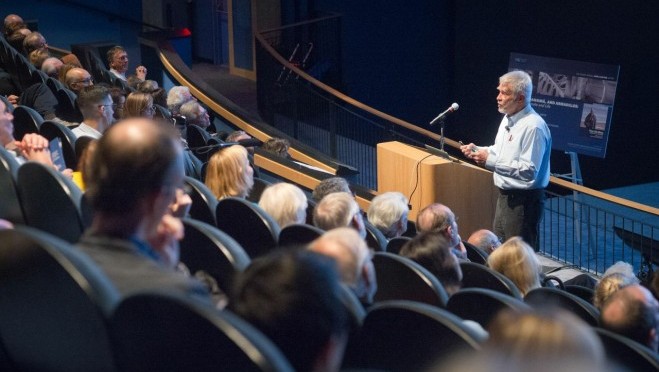PAOC Spotlights
Geophysicist Peter Molnar Takes Down a Popular Scientific Theory at the Lorenz Center's John Carlson Lecture
Peter Molnar, professor of geological sciences at the University of Colorado at Boulder, presented “Big Cats, Panamá, and Armadillos: A Story of Climate and Life" at the 2014 John Carlson Lecture.
***
Approximately three million years ago, an enormous ice sheet pushed southward from the arctic, covered what is now Canada and stretched down to modern day Missouri, becoming the first ice age to occur in hundreds of millions of years. Ever since, Earth’s climate has passed in and out of ice ages roughly every 40,000 years with the last ice sheet retreating about 20,000 years ago.
What triggered this enormous shift in climate? A commonly accepted explanation relies on the assumption that the Isthmus of Panama closed at that time, creating a land bridge between North and South America that blocked the essential ocean currents keeping the ice ages at bay.
 At the MIT Lorenz Center's 4thJohn Carlson Lecture, prominent geophysicist Peter Molnar dismantled this long accepted explanation for why Earth's ice ages began when they did.
At the MIT Lorenz Center's 4thJohn Carlson Lecture, prominent geophysicist Peter Molnar dismantled this long accepted explanation for why Earth's ice ages began when they did.
Molnar pulled up Wikipedia’s entry for the Isthmus of Panamá, which presents a dramatic sequence of geological events: As continental plates collided 3 million years ago, a thin rib of land emerged, closing the gap between the North and South American continents. This major event separated the Atlantic and Pacific Oceans, and as a consequence, transformed ocean circulation in a way that allowed ice sheets to grow on the North American continent and to give us recurring ice ages.
Around that same time in Earth’s history, fauna began to migrate across the continents in an event called the Great American Biotic Interchange. The emergence of the Isthmus of Panamá, as accepted scientific theory goes, created a land bridge that allowed the animals to cross the continents. Fossil evidence shows that North American natives such as bears, mastodons, ancestors of big cats, camels, and horses traveled into South America, while ancestors of modern day armadillos, porcupines, sloths, anteaters, and opossums migrated into North America.
Molnar then proceeded to tear down this elaborate interpretation in minutes. “We can reject it,” he said. “It has no foundation.” He presented fossil findings that frogs, salamanders, and snakes crossed the continents between 6 and 19 million years ago, as well as new geological evidence that the Isthmus of Panama actually emerged 20 million years ago—far before the commonly cited 3 million. That’s one hole in the story that the emergence of a land bridge directly enabled the Great American Biotic Interchange—it was already there.
Molnar’s alternative explanation hinges on the slow global cooling that eventually sustained an ice sheet briefly, for no more than 20,000 years, on Canada 3 million years ago. During this ice age, the climate in Panama shifted from the hot, wet, mosquito-infested jungle we know today to a drier, cooler savannah grassland environment favorable to the migration of animals such as armadillos and saber-toothed cats. This change in Panama alone would have allowed animals to cross between continents.
“Did the emergence of the Isthmus of Panamá, whenever it occurred, have anything to do with Ice Ages?” asked Molnar, “I think it had nothing to do with it.”
Molnar admitted that he did not answer the larger motivating question about what geological processes transformed Earth’s climate from one with no ices ages to another with recurring ice ages. He will be working on that one for a long time. Rather, his talk proved the importance of challenging core assumptions in science. “The most important part of science is asking good questions,” he told the young scientists and high schoolers in the audience.
Before the lecture, MIT and the aquarium hosted an exhibition of the iGlobe, a new tool for earth science education. By projecting scientific data such as weather patterns, ocean circulation, and land temperature on a sphere, the iGlobe provides an intuitive, accurate, and fun way to represent the interconnectedness of Earth’s systems. Researchers from MIT, led by Glenn Flierl, Professor of Oceanography in MIT’s Department of Earth, Atmospheric and Planetary Sciences, recently partnered with iGlobe Inc. to educate students and the general public and improve the presentation of spatial information and computer model results on the iGlobe.
The John Carlson Lecture communicates exciting new results in climate science to the general public. The lecture is made possible by a generous gift from John H. Carlson '83 to the Lorenz Center in the MIT Department of Earth, Atmospheric and Planetary Sciences.
Watch the entire talk at MIT Tech TV
Look for more pictures from this event on the EAPS flickr page